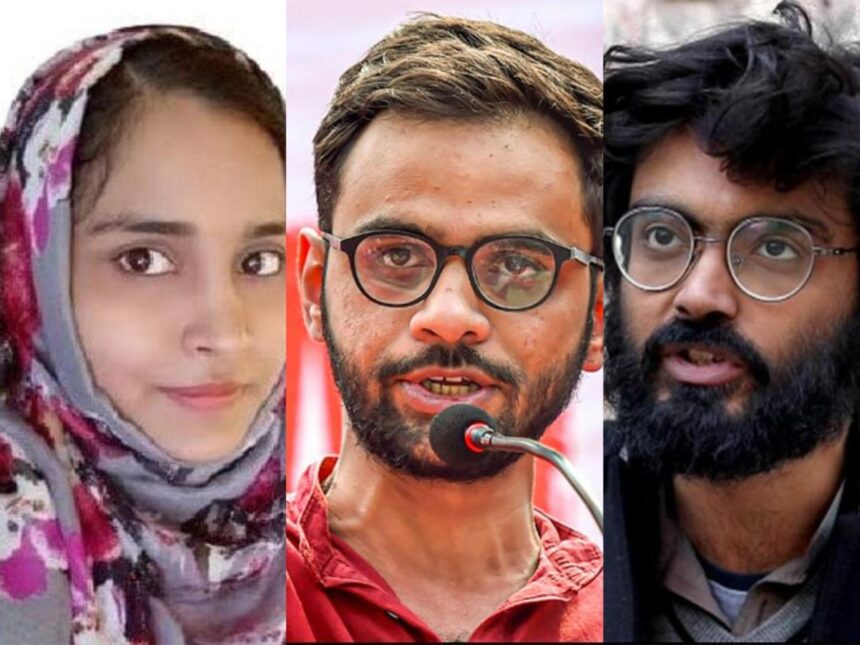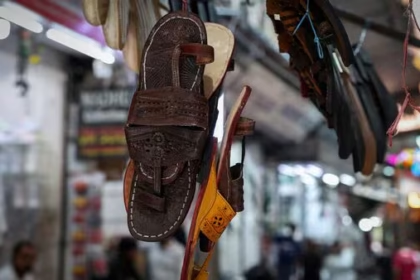Del HC Denies Bail to Gulfisha Fatima, Sharjeel Imam & Others in Delhi Riots Case
Delhi high court’s September 2 order denying bail to nine individuals in the “Delhi riots cases,” with a focus on the case of Umar Khalid. I noted that this order – like the orders before it in the same case – adopts an “eyes wide shut” approach to the evidence before it. Faced with the fact that Khalid at no point called for or instigated communal violence, the court falls back upon a Moscow Trials-style invocation of “conspiracy”, grounded in vague and uncorroborated statements from anonymous “protected” witnesses, filling in the gaps in the prosecution’s case with its own assumptions and inferences, and mis-applying (or not applying) existing legal standards.
In many respects, the bail rejections of the other accused individuals follow a similar pattern of reasoning. Out of these, the case of Gulfisha Fatima stands out as the most glaring. The allegations against her rest almost entirely on the statements of anonymous, “protected” witnesses, without any corroboration. The earliest stage when such corroboration may take place is at the trial. But given that there are nearly 900 witnesses to be examined and considering the sluggish pace of Indian criminal trials, it could easily take around ten years.
Despite this, the high court maintains that the trial is proceeding at a “normal pace” and that expediting it would be “unfair” to the rights of all parties. Stripped of legal jargon, this essentially means that a person may end up spending as many as 15 years in jail solely on the basis of anonymous witness statements. The comparison is chilling—if Stalin’s infamous prosecutor, Andrey Vyshinsky, were alive today, he might have found useful notes to take from the Delhi High Court’s reasoning.
An argument was also made by Fatima’s lawyer that in all material respects, her case was similar to that of Devangana Kalita and Natasha Narwal, who had previously been granted bail (for the extraordinary journey of that case, see here and here). Bail, therefore, was sought on the well-established ground of parity. How does the high court respond to this? It needs to find something to distinguish the two cases, and so it turns to the theatre of the absurd:
The WhatsApp groups that the Appellant allegedly created, of which one noticeably, revolve around coordination in protests and ensuring that as many women participate in the protests. This factum of creation of these two groups cannot be seen in isolation, the consideration should weigh in on broad probabilities as per the settled law.
But there is – it should be needless to state – nothing illegal about forming WhatsApp groups to coordinate protests, and to encourage the participation of women in the protests. In fact, how else are you going to coordinate a protest other than through a WhatsApp group (now if you used Signal, that would presumably be even more serious indication of a conspiracy!)? We therefore come back to the initial point about how, in this case, each of the three courts involved have filled in the huge, gaping hole of the prosecution’s case with an assumption that is totally untethered from reality.
To close the gap between the fact that these nine people were involved in the democratically legitimate activity of organising protests against the CAA, and the fact of communal violence that claimed the lives of 54 people – a gap that is as vast as the grand canyon – the high court has built a bridge of smoke where the organisation of protests itself becomes the conspiracy. In essence, what we have is an implicit attempt by the court to criminalise protest itself, because – as noted above – there is no actual, tangible evidence of the protesters themselves engaging in acts or instigation of violence.
Apart from the specific case of Fatima, there are two other strands that run through the multiple denials of bail in the judgment. The first is what I call a judicial double-standard. In short, where there is a fact that is potentially favourable to the individuals, and militates in favour of granting bail, the high court cites the Watali judgment, claps its hands over the eyes, and refuses to consider it.
However, when it comes to reasons against granting bail, the court is happy to go deep into the evidence, and make all kinds of inferences that are not even on the record. So, for example, in the case of one of the individuals, Shifa-ur-Rahman, there is an allegation that funds raised for the protests have been used for instigating the riots. There is, of course, no direct evidence of this.
The high court, however, makes the extraordinary claim that because Shifa-ur-Rahman was the president of a Jamia student organisation called AAJMI, “the possibility of misuse of the position … cannot be ruled out.” This speculative “possibility” then becomes one of the bases for refusing him bail—a leap of logic that appears bizarre in its own right.
The judicial inconsistency becomes clearer when, in response to defence counsels’ argument that the delay in recording the statements of the “anonymous” witnesses undermines their credibility in establishing a prima facie case, the court cites Watali to assert that such questions cannot be considered at the stage of bail. Yet, one must ask: which “possibility” carries more weight—the supposed risk of Rahman misusing his student leadership role, or the likelihood that delayed, anonymous witness statements demand skepticism? Which of these truly ought not to be “ruled out”?
The judicial inconsistency becomes clearer when, in response to defence counsels’ argument that the delay in recording the statements of the “anonymous” witnesses undermines their credibility in establishing a prima facie case, the court cites Watali to assert that such questions cannot be considered at the stage of bail. Yet, one must ask: which “possibility” carries more weight—the supposed risk of Rahman misusing his student leadership role, or the likelihood that delayed, anonymous witness statements demand skepticism? Which of these truly ought not to be “ruled out”?
In sum, it seems that the high court will refrain from conducting a “mini-trial” only when doing so would make the case for bail inevitable; in all other cases, the high court is perfectly happy to conduct a host of mini-trials, draw out all kinds of inferences from the facts on record, and use those inferences to deny bail. Judicial hypocrisies of this kind – and this inconsistent approach to assessing the evidence – are rife throughout the judgment.

The second strand is that, on the one hand, when considering arguments for parity, the high court goes to great lengths to emphasise, re-emphasise, and re-re-emphasise that every individual’s role in the “conspiracy” is different. It even invokes the most microscopic details—such as Gulfisha Fatima starting a WhatsApp group—to justify denying bail by arguing that no two cases are exactly alike.
Yet, in the very same judgment, the court seems comfortable lumping people together when it suits its reasoning. Umar Khalid and Sharjeel Imam are clubbed as the “intellectual masterminds,” while others are grouped en masse based on which protest sites they were associated with or their loosely defined organisational roles. This selective approach exposes a striking inconsistency in the court’s reasoning.
While this may seem innocuous, it is not: as noted in the previous posts, and the posts before, this generic clubbing allows the high court to avoid its obligation of scrutinising the evidence to ensure that the allegations against each individual are specific and particularised, not generic and inferential. This clubbing allows the high court to justify the denial of bail by – once again – invoking the shibboleth of the “conspiracy”, and casting the nine individuals before it in shadowy, undefined roles within that conspiracy.
Finally, after all this, it is also important to consider separately the case of Sharjeel Imam, as it is he who has been – since the beginning of the protests against the CAA – most strongly vilified in the media. In this judgment, Imam is clubbed alongside Khalid, and therefore, many of the arguments made in the previous post apply equally to him. There is the additional point to note that Imam was already in prison from January 28, 2020 onwards – almost a full month before the riots began.
Other than the issue of a “conspiracy” – which I have addressed both in the last post and in this post – the additional allegations against Imam pertained to certain speeches that he had delivered. The first – referenced by the court in its analysis – was about a “chakka jam” in Delhi that would disrupt the flow of services. The second – quoted in the submissions of the State – was a speech about cutting off access to the north-eastern states beyond Assam until the government listened to the protesters. This, it was argued, was secessionist.
Let us take each speech in turn. On the chakka jam, it is important to remember that India itself owes its existence as a nation-state to mass mobilisations and protests that were inherently disruptive—and the chakka jam is one such form. Nor is this legacy confined to the freedom struggle. In her book Hailing the State, Lisa Mitchell traces unconventional ways in which Indians have long made claims upon the State beyond the ballot box, from the “rail roko” to the “chakka jam.” These protests carry a particular history and lineage, practised by people of different persuasions across time and place.
It may certainly be argued that the State has the right to respond to such disruptive methods through legal channels. But what has happened in this case is far more troubling: the use of anti-terror laws to criminalise what was, at its core, a political protest. Crucially, the link between the protesters and the alleged violence remains unproven, making the State’s response not only disproportionate but also deeply problematic.
On the second speech, pertaining to the North-east: while the speech does not figure in the court’s analysis, it is worthwhile to clarify that this cannot be a ground for denying bail under an anti-terror law either. This is because the Constitution does not allow for the punishing of violent speech; it allows for the punishing of incitement to violence. There is a crucial difference between the two.
To say that access to the north-east will be cut off until the government listens to the protesters’ demands is, at its highest, violent speech. If, on the other hand, Imam had at his command a private army that would march upon his bidding to actually cut off access to the north-east, then that would be incitement to violence. Needless to say, nothing of the sort happened. Indeed, this distinction between violent speech and incitement to violence has been a consistent part of the Supreme Court’s free speech jurisprudence, from Shailabala Devi (1953) to Shreya Singhal (2015). Under that jurisprudence, it must be stated that Imam is as entitled to bail as his eight co-accused in these orders.
As an aside, it’s probably worth remembering that if every instance of violent speech was met with a UAPA FIR and a half-decade in jail, then a lot of people who have said – and done – much worse than Imam, would be behind bars at the moment. They are not. He is.
At the end of the day, reading the high court’s analysis of Imam’s case, and indeed, reading the 133-page bail order as a whole, the overarching framework is clear. It depends upon what Mourid Barghouti once called “a simple linguistic trick.” This simple linguistic trick is a framing device: instead of framing the anti-CAA movement as a legitimate collective protest with legitimate collective political goals, in which Muslim activists played a prominent role (it is no coincidence that all the nine individuals whose bails were denied yesterday are Muslims), the court frames it as a conspiracy of violence.
Through this “simple linguistic trick”, the violence that actually happened is linked to the protests, as though the protests, by design, carried within them the seeds of violence. And the moment you adopt that framing, WhatsApp groups become seedbeds of secession, speeches preaching peace start carrying double meanings, and dissent turns into treason.
It is crucial, therefore, for the judicial institution to urgently correct this distorted way of seeing. With every passing day that it does not do so, the miscarriage of justice will become more and more severe, until one day, it will indeed be too little, too late.
Also Read: Pro Kabaddi League’s Most INTENSE Match of the Season Sees Jaipur Edge Out Patna 39-36








